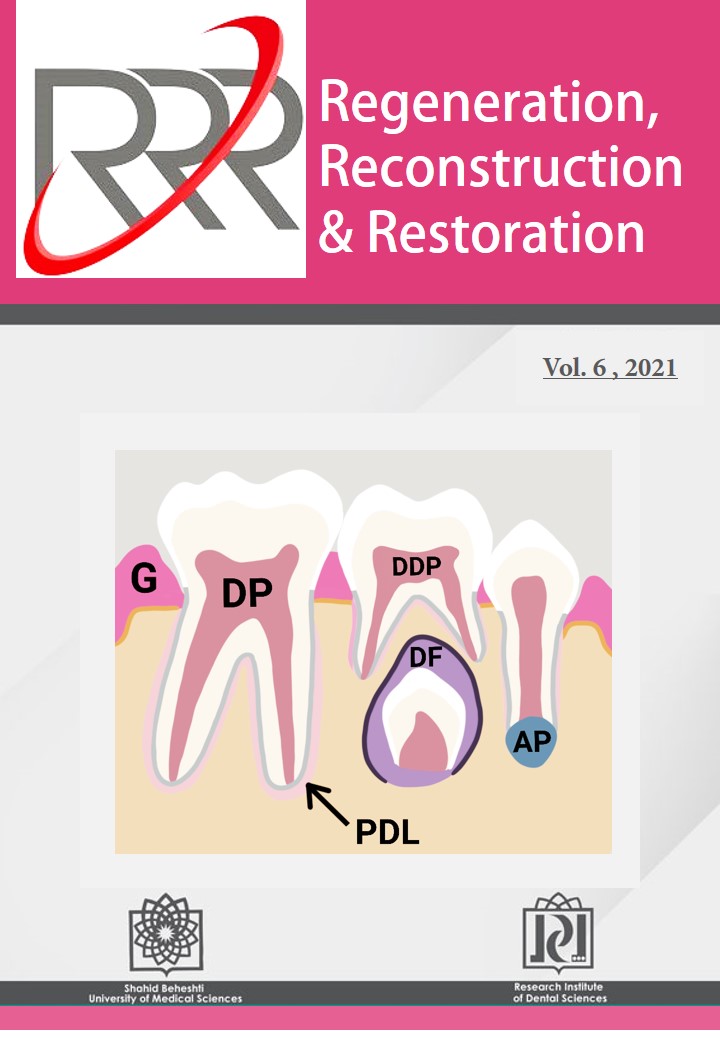Incidence of Maxillofacial Fractures and Their Care Proceedings in Patients Referred to Shariati Hospital in 2019-2020: A Prospective Study
Regeneration, Reconstruction & Restoration (Triple R),
Vol. 6 (2021),
13 March 2021
,
Page e12
https://doi.org/10.22037/rrr.v6i.38570
Abstract
Introduction: Trauma to maxillofacial structures can cause growth disorders and deformities in craniofacial bones, permanently affecting patient’s quality of life. Moreover, a significant increase in incidence of maxillofacial fractures due to more widespread use of motor vehicles and interpersonal assaults cannot be overlooked. This study evaluated the incidence of maxillofacial fracture types and the employed management course in patients referred to Shariati Hospital, Tehran, Iran over 2019-2020.
Materials and Methods: In this cross sectional study, patients with maxillofacial traumas referred to this center were selected using census sampling method. Age, gender, etiology of trauma, location of fractures, drug and/or alcohol addiction, duration of referral until hospitalization, opt surgical treatments and recruitment were documented using clinical examinations and interview. Obtained results were reported by means of the descriptive statistics methods.
Result: Two hundred and twenty-three (223) patients (83.4% males and 16.6% females) were enrolled. The mean age of patients was 29.95 years. The etiology of fractures were motor vehicle accidents (85; 38.1%), motorcycle accidents (36; 16.1%); interpersonal assaults (33; 14.8%), falls (56; 25.1%), sport related injuries (6; 2.7%) and industrial incidents (5; 2.2%). In 181 patients (81.5%), there was no fracture in the other parts of the body while in 41 patients (18.4%) concurrent fractures in other sites were observed as well. The most anatomic site of the fracture was mandible. The mean time passed from the referral until hospitalization, surgery and recruitment day was 2.09, 6.89 and 10.56 days respectively.
Conclusion: In patients with maxillofacial fractures referred to Shariati Hospital during 2019-2020, the fractures predominantly occurred in males,in the mandible and mostly due to traffic accidents on motor vehicles, consistent with reported data obtained in other developing countries.
- Maxillofacial fractures
- Incidence
- Management course
How to Cite
References
2. Gassner R, Tuli T, Hachl O, Rudisch A, Ulmer H. Cranio-maxillofacial trauma: a 10 year review of 9,543 cases with 21,067 injuries. J Craniomaxillofac Surg. 2003;31(1):51-61.
3. Mesgarzadeh AH, Shahamfar M, Azar SF, Shahamfar J. Analysis of the pattern of maxillofacial fractures in north western of Iran: A retrospective study. Journal of emergencies, trauma, and shock. 2011;4(1):48-52.
4. Kadkhodaie MH. Three-year review of facial fractures at a teaching hospital in northern Iran. The British journal of oral & maxillofacial surgery. 2006;44(3):229-31.
5. Qudah MA, Bataineh AB. A retrospective study of selected oral and maxillofacial fractures in a group of Jordanian children. Oral Surg Oral Med Oral Pathol Oral Radiol Endod. 2002;94(3):310-4.
6. Ozkaya O, Turgut G, Kayali MU, Ugurlu K, Kuran İ, Bas L. A retrospective study on the epidemiology and treatment of maxillofacial fractures. Ulus Travma Acil Cerrahi Derg. 2009;15(3):262-6.
7. Bataineh AB. Etiology and incidence of maxillofacial fractures in the north of Jordan. Oral Surg Oral Med Oral Pathol Oral Radiol Endod. 1998;86(1):31-5.
8. Afzelius LE, Rosen C. Facial fractures. A review of 368 cases. International journal of oral surgery. 1980;9(1):25-32.
9. Cabalag MS, Wasiak J, Andrew NE, Tang J, Kirby JC, Morgan DJ. Epidemiology and management of maxillofacial fractures in an Australian trauma centre. J Plast Reconstr Aesthet Surg. 2014;67(2):183-9.
10. Maliska MC, Lima Junior SM, Gil JN. Analysis of 185 maxillofacial fractures in the state of Santa Catarina, Brazil. Braz Oral Res. 2009;23(3):268-74.
11. Natu SS, Pradhan H, Gupta H, Alam S, Gupta S, Pradhan R, et al. An epidemiological study on pattern and incidence of mandibular fractures. Plast Surg Int. 2012;2012:834364.
12. Axmon O. Maxillofacial fractures in a Swedish population–incidence and etiology. 2014.
13. Sethi RK, Kozin ED, Fagenholz PJ, Lee DJ, Shrime MG, Gray ST. Epidemiological survey of head and neck injuries and trauma in the United States. Otolaryngol Head Neck Surg. 2014;151(5):776-84.
14. Ramouz A, Hosseini M, Vahdati SS. Epidemiology of Head and Neck Fractures Caused by Motorcycle Accidents. Iranian Journal of Emergency Medicine. 2016;3(1):23-7.
15. Al Ahmed HE, Jaber MA, Abu Fanas SH, Karas M. The pattern of maxillofacial fractures in Sharjah, United Arab Emirates: a review of 230 cases. Oral Surg Oral Med Oral Pathol Oral Radiol Endod. 2004;98(2):166-70.
16. Cheema SA, Amin F. Incidence and causes of maxillofacial skeletal injuries at the Mayo Hospital in Lahore, Pakistan. The British journal of oral & maxillofacial surgery. 2006;44(3):232-4.
17. Erol B, Tanrikulu R, Gorgun B. Maxillofacial fractures. Analysis of demographic distribution and treatment in 2901 patients (25-year experience). J Craniomaxillofac Surg. 2004;32(5):308-13.
18. Adi M, Ogden GR, Chisholm DM. An analysis of mandibular fractures in Dundee, Scotland (1977 to 1985). The British journal of oral & maxillofacial surgery. 1990;28(3):194-9.
19. Saadat S, Nouralishah B, Khaji A. Epidemiology of Head and Neck Injuries in Tehran. The Neuroscience Journal of Shefaye Khatam. 2013;1(4):17-21.
20. Ansari MH. Maxillofacial fractures in Hamedan province, Iran: a retrospective study (1987-2001). J Craniomaxillofac Surg. 2004;32(1):28-34.
21. Zandi M, Khayati A, Lamei A, Zarei H. Maxillofacial injuries in western Iran: a prospective study. Oral and maxillofacial surgery. 2011;15(4):201-9.
22. Zamani-Alavijeh F, Bazargan M, Shafiei A, Bazargan-Hejazi S. The frequency and predictors of helmet use among Iranian motorcyclists: A quantitative and qualitative study. Accid Anal Prev. 2011;43(4):1562–9.
- Abstract Viewed: 151 times
- PDF Downloaded: 59 times
